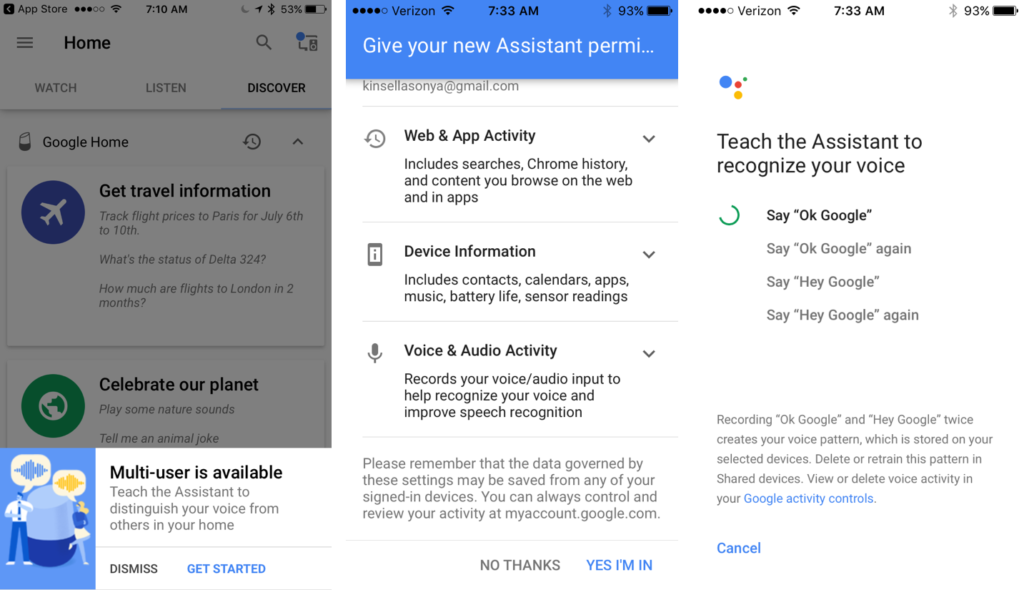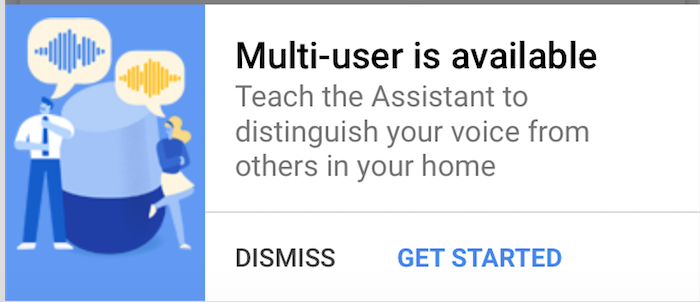Google Home Can Now Distinguish Multiple Users By Voice
Google Home can now distinguish multiple users by voice. Voicebot was among the first to recognize that Google’s promise to make a truly personal voice assistant also introduced a glaring flaw in the initial implementation. Unlike phones, Google Home was designed for common living spaces where multiple users could interact with it, but the personalization was limited to one person. This was an inconvenience at one level. Only one person could actually receive calendar, traffic and other personalized updates. However, there was a more significant privacy issue. The limitation also meant that anyone in speaking range of the device could ask Google for information and personal details about the primary device user could emerge.
At launch, Google’s head of infrastructure indicated it was a “known issue” and wanted to resolve it quickly. The solution took six months to arrive, but it is elegant. The voice identification multi-user support also offers Google Home a recognizable advantage over Amazon Echo. While most people will focus on the novelty of multiple user support by voice signature, the personalization and privacy aspects are the foundation for some significant usability breakthroughs.
Easy to Set Up and Works Right Away
Multi-user support can be set up in just a couple of minutes by opening your Google Home app. Your app should have a notification at the bottom or top or you can select the menu > more settings > shared devices to enable it. You then simply need to give Google Assistant permission to Assistant to record your voice if you haven’t already and say “Ok Google” and “Hey Google” twice. The process worked flawlessly for three members of my household.

Google even offers an easy way for your to invite other members of your household after enabling feature. You simply text them a link so they can go through the set-up process. In addition, you don’t even need to be near the device to register as a user and teach Google Assistant your voice. The voice signature recognition is captured through the mobile app and then enabled through the device.
How Does it Work
Yuri Pinsky, Product Manager for Google Assistant, explained how the voice recognition worked in a Google Assistant blog post yesterday.
When you connect your account on a Google Home, we ask you to say the phrases “Ok Google” and “Hey Google” two times each. Those phrases are then analyzed by a neural network, which can detect certain characteristics of a person’s voice. From that point on, any time you say “Ok Google” or “Hey Google” to your Google Home, the neural network will compare the sound of your voice to its previous analysis so it can understand if it’s you speaking or not.
Is Google Starting to Set the Standard for Voice Assistant Features?
Amazon had already addressed the multiple user issue with Alexa by allowing users to easily switch between accounts. Google has now surpassed that implementation by enabling Google Assistant to recognize users by their voices. This eliminates a step. You don’t need to switch accounts. Google introduced a similar convenience with Actions being available automatically. Amazon recently matched that feature, but previously you needed to enable an Alexa skill before you could access the functionality.
Amazon skill leads with total number of voice applications (i.e. skills) for users by a large margin, has a growing developer tool ecosystem and robust support for developers, but it needs to pay close attention to Google’s usability features. Gartner predicts that 75% of U.S. households will have smart speaker style voice assistants like Google Home and Amazon Echo by the end of 2020. That is up from Edison Research’s estimate of 7% of households at the end of 2016. That means 90% of the consumer market is still up for grabs. Usability features will be a big focus in 2017 as device makers position themselves for user adoption.
Why Notifications Are Critical for Google Home and Amazon Echo









